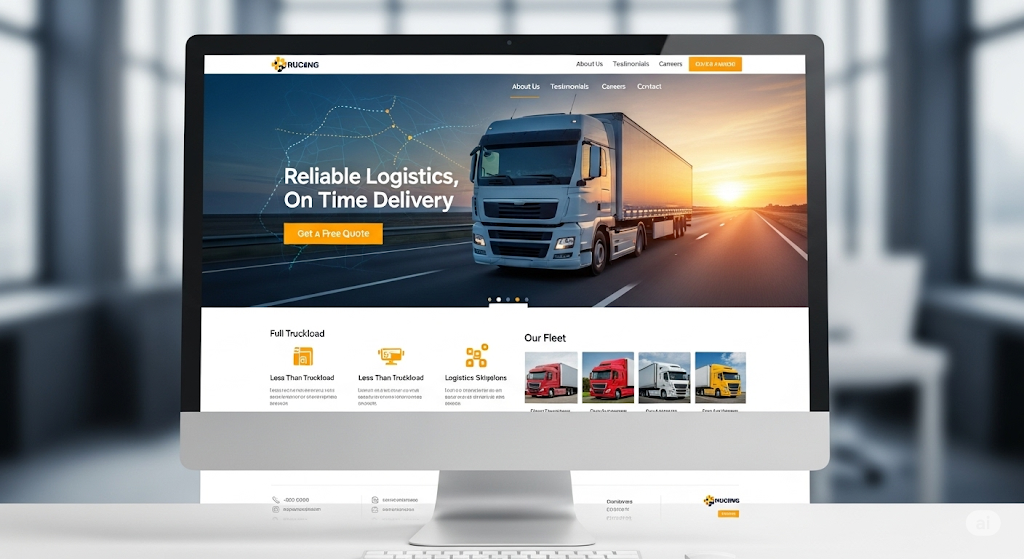In today’s fast-paced logistics industry, your website is more than just a digital brochure — it’s the backbone of your marketing, sales, and customer service efforts. For trucking companies competing in a crowded market, professional web design for trucking businesses is essential to stand out, attract clients, and build trust. A well-designed, user-friendly website ensures your business is visible, credible, and ready to convert visitors into loyal customers.
1. First Impressions Matter in Trucking
When a shipper, freight broker, or business owner lands on your site, they’re making a judgment within seconds. Outdated design, slow loading speed, or cluttered layouts send the wrong message about your professionalism and reliability.
A professional trucking website uses:
-
Clean, modern layouts
-
Consistent branding with company colors and logo
-
Clear navigation so users find information quickly
-
High-quality images of your fleet, drivers, and facilities
A positive first impression doesn’t just encourage potential clients to explore your services — it builds confidence in your ability to handle their transportation needs.
2. Mobile-Responsive Design is Non-Negotiable
Over 60% of online searches now come from mobile devices, and many trucking industry decision-makers search for carriers on their phones while on the go. Professional trucking websites must be mobile-first, meaning they load quickly and display perfectly on smartphones and tablets.
Key mobile features include:
-
Tap-to-call phone numbers for instant contact
-
Clickable maps and route information
-
Easy-to-read text without zooming
-
Fast load times, even on weaker data connections
Google also prioritizes mobile-friendly websites in search results, so this directly impacts your ranking and lead generation.
3. SEO-Optimized to Attract More Clients
A good-looking website is useless if nobody can find it. That’s why professional web design for trucking businesses integrates SEO best practices from the start. This means optimizing page titles, meta descriptions, image alt tags, and content with industry-specific keywords like “freight transportation services” or “logistics solutions.”
Local SEO is especially important for regional carriers — optimizing for city and state keywords ensures nearby shippers can easily find your company.
4. Showcasing Services and Capabilities Clearly
Potential customers want to quickly understand what you do and how you can help. A professionally designed trucking website organizes this information in an intuitive way:
-
Dedicated pages for each service (e.g., dry van hauling, refrigerated transport, flatbed shipping)
-
Clear descriptions of your routes, coverage areas, and industries served
-
Downloadable rate sheets, safety certifications, and case studies
By presenting your services in a structured and visually appealing way, you help prospects make faster decisions.
5. Building Trust Through Reviews and Case Studies
Shippers want proof you can deliver. Incorporating client testimonials, safety records, and successful delivery case studies builds trust instantly. Professional designs place these trust signals in visible spots, such as the homepage and service pages, so visitors see them without searching.
6. Conversion-Optimized for More Leads
The ultimate goal of your trucking website is to generate leads. That’s why design and functionality should guide visitors toward taking action. Effective trucking web designs include:
-
Prominent “Request a Quote” buttons
-
Short, easy-to-complete contact forms
-
Live chat or chatbot features for instant communication
-
Email sign-up forms for future marketing
When these elements are integrated seamlessly into the design, your site works like a 24/7 sales representative.
7. Fast Loading Speed Improves User Experience
Speed is everything in logistics — and the same applies to your website. A slow site increases bounce rates and costs you leads. Professional web developers optimize images, use clean code, and implement caching to keep load times under 3 seconds. This not only helps with user satisfaction but also boosts SEO rankings.
8. Compliance and Accessibility
Modern trucking websites must comply with accessibility guidelines so all users — including those with disabilities — can navigate your site. Professional web design ensures ADA compliance, which also helps avoid legal issues and expands your potential audience.
Final Thoughts
In the competitive trucking industry, having a functional and visually appealing site isn’t optional — it’s a business necessity. Professional web design for trucking businesses ensures your company makes a strong first impression, ranks higher in search results, and converts more visitors into paying clients. By combining mobile responsiveness, SEO optimization, clear service presentation, and trust-building elements, your website can become a powerful growth engine for your business.







